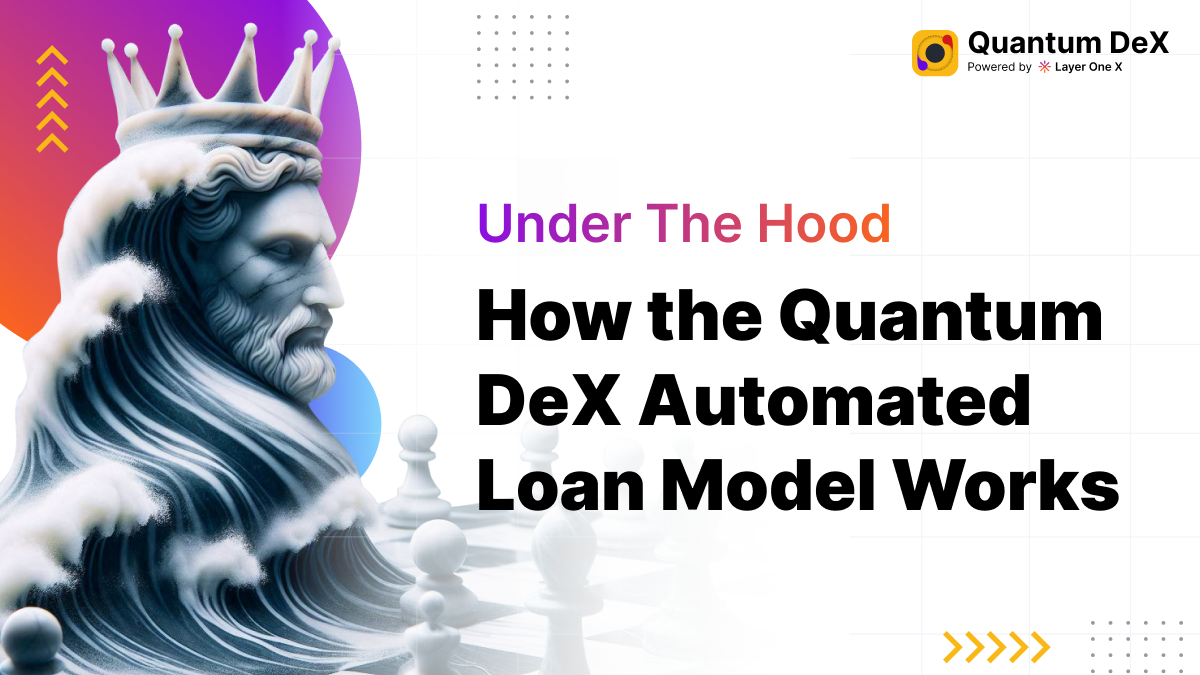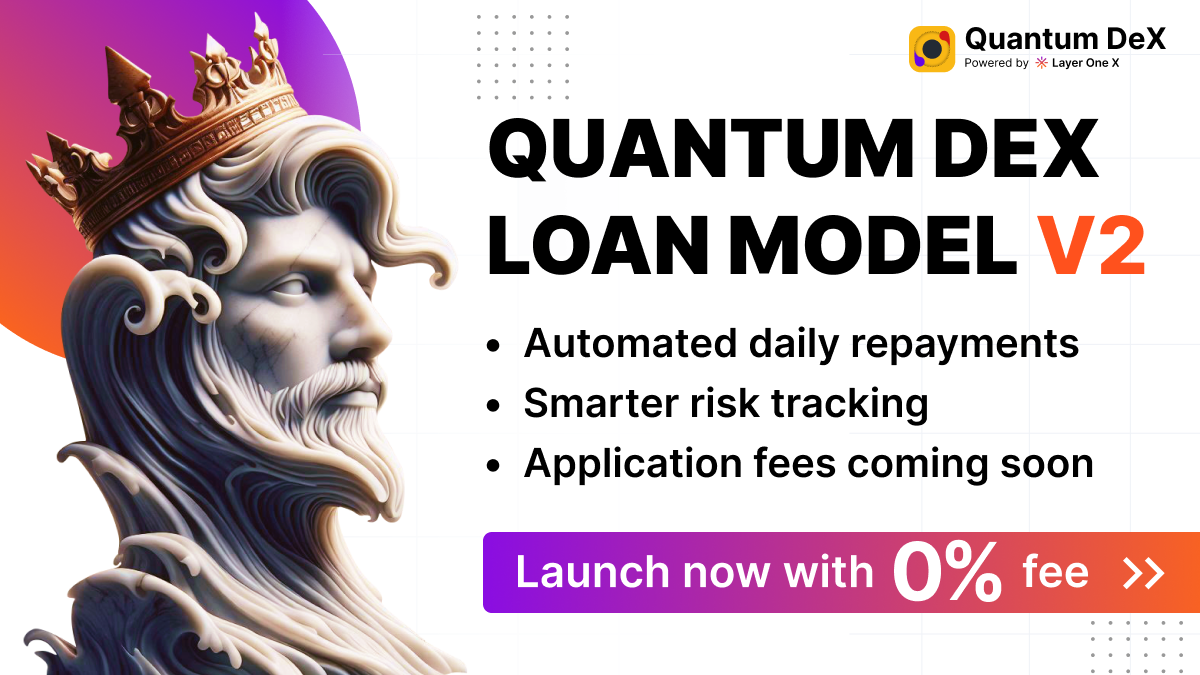By Quantum DeX Engineering | A Modular Smart Contract System for DeFi Liquidity Loans
Introduction
The Quantum DeX Loan Protocol is a fully decentralized, smart contract powered liquidity system. Projects can bootstrap their token’s liquidity by borrowing WL1X backed capital, providing their own tokens, and instantly launching on Quantum DeX all without centralized approvals, backend servers, or hidden intermediaries.
Every step, from collateral deposit to repayment tracking, is executed entirely on chain. This post explores how the system works under the hood and what makes it uniquely robust, trustless, and capital efficient for project teams.
Modular Architecture Overview
The protocol is composed of six on-chain smart contracts, each modularized by function:
|
Smart Contract |
Responsibility |
|---|---|
|
Collateral Acceptance Address |
Handles native/erc20 collateral deposits and generates unique deposit IDs |
|
Collateral User Register |
Records user loan configurations and ties them to specific deposit IDs |
|
Mediator Contract |
Coordinates token deposits and Quantum DeX liquidity provisioning |
|
GuardianNFT Contract |
Custodies LP NFTs, tracks ownership, and collects fees |
|
Repayment Contract |
Manages USD denominated installment based loan repayment in WL1X |
|
Loan Repayment |
Lightweight contract for simplified repayment tracking |
Full Lifecycle: End-to-End On-Chain Execution
Phase 1: Collateral Deposit and Loan Configuration
Step 1.1: Collateral Deposit
CollateralAcceptanceAddress.depositERC20(tokenAddress, amount);
// OR
CollateralAcceptanceAddress.depositNative();
- Accepts ETH or any ERC20 token.
- Generates a unique deposit ID (keccak256(user, counter, timestamp)).
- Emits DepositReceived event and stores deposit data in deposits mapping.
Step 1.2: Loan Registration
CollateralUserRegister.registerCollateralData(
user,
loanAmount,
collateralAmount,
loanTerms,
tokenPoolAddressQdex,
tokenContractAddressQdex,
tokenContractAddressCollateral,
depositId
);
- Ties deposit to loan configuration.
- Stores all parameters on-chain.
- Emits CollateralDataRegistered event.
Phase 2: Token Deposit and Liquidity Provision
Step 2.1: Project Token Deposit
MediatorContract.depositProjectToken(
user,
token,
amount,
depositId,
poolAddress
);
- Accepts project token deposits.
- Validates user registration through CollateralUserRegister.
- Tracks deposits by user and pool for later liquidity creation.
Step 2.2: Uniswap V3 Liquidity Creation
MediatorContract.addLiquidityForUser(
user,
key,
projectToken,
amount0,
amount1,
fee,
tickLower,
tickUpper
);
- Calls Quantum DeX’s mint() function.
- Ensures token ordering and pair validity.
- Mints the LP NFT and sends it directly to GuardianNFTContract.
Phase 3: NFT Custody and Ownership
Step 3.1: Receive LP NFT
GuardianNFTContract.onERC721Received(operator, from, tokenId, data);
- Receives NFT directly from Uniswap.
- Validates contract and operator sender.
- Emits PositionReceived event.
Step 3.2: Assign Ownership
GuardianNFTContract.setPositionOwner(tokenId, user);
- Records logical owner without transferring the NFT. The ownership remains with the Guardian contract.
Phase 4: Installment-Based Loan Repayment
Step 4.1: Create Repayment Schedule
RepaymentContract.createRepaymentScheduleForProject(
borrower,
totalAmount,
interval,
monthlySchedule,
registerContractId
);
- Defines total amount in USD (8-decimal precision).
- Stores schedule for each installment month.
- Generates unique loanId using keccak256.
Step 4.2: Make Installment Payments
RepaymentContract.payInstallment(loanId, monthIndex, amount);
- Verifies borrower identity.
- Converts USD amount to WL1X using on-chain price feed.
- Applies partial payments automatically.
- Overpayments forwarded to next month.
- Payment completion is logged and updated on-chain.
Design Principles: Trustless, Modular, and Accountable
No Central Control
- No backend logic, approval layers, or manual interventions.
No Custodial Ownership
- LP NFTs are held by GuardianNFTContract, never exposed to user wallets.
- Projects cannot remove liquidity or run away with LPs until the loan is repaid back providing security and safe trading opportunities to the users.
Real-Time State Tracking
- Every deposit, repayment, and pool creation is timestamped and logged.
- Project status is traceable by querying smart contract state (e.g., isDepositIdRegistered, hasPaidInstallment).
Transparent Conversion and Risk Mitigation
- WL1X price is updated manually by the protocol.
- Protocol prevents minting LP tokens if collateral or token conditions are not met.
- Risk logic can be expanded to include AI scoring or penalty triggers.
Integration Points
- ERC20/ERC721 standards: For collateral, LP tokens, and token deposits.
- Manual Price Oracle: WL1X/USD price feed updated by governance wallet.
Why It Matters
- Projects can launch instantly with protocol-supplied WL1X liquidity.
- No need for upfront capital or centralized liquidity support.
- Repayment schedules are fixed, predictable, and on-chain.
- NFT-based liquidity ensures pools are safe, trackable, and tamper-proof.
This protocol enables permissionless liquidity loans that are composable, verifiable, and resistant to rug-pulls.
Conclusion
Quantum DeX’s Loan Protocol is a blueprint for how liquidity and credit can be offered in DeFi without any centralized actors. Every component, from the deposit process to the repayment lifecycle, operates through deterministic smart contracts deployed on-chain.
If you’re a builder looking to launch your token with zero-interest, collateralized liquidity, explore our loan system:



